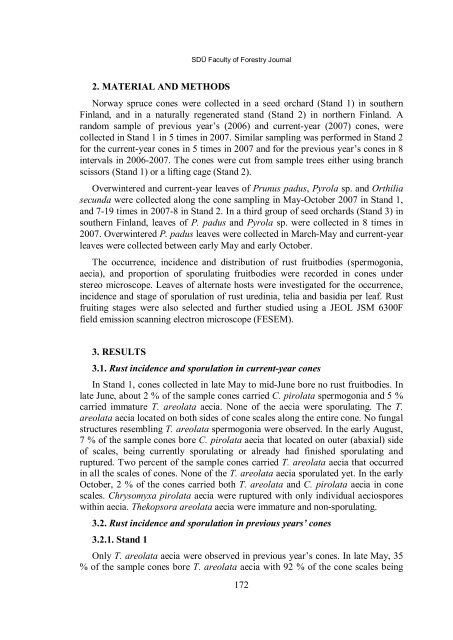sdu faculty of forestry journal special edition 2009 - Orman Fakültesi
sdu faculty of forestry journal special edition 2009 - Orman Fakültesi
sdu faculty of forestry journal special edition 2009 - Orman Fakültesi
Create successful ePaper yourself
Turn your PDF publications into a flip-book with our unique Google optimized e-Paper software.
2. MATERIAL AND METHODS<br />
SDÜ Faculty <strong>of</strong> Forestry Journal<br />
Norway spruce cones were collected in a seed orchard (Stand 1) in southern<br />
Finland, and in a naturally regenerated stand (Stand 2) in northern Finland. A<br />
random sample <strong>of</strong> previous year’s (2006) and current-year (2007) cones, were<br />
collected in Stand 1 in 5 times in 2007. Similar sampling was performed in Stand 2<br />
for the current-year cones in 5 times in 2007 and for the previous year’s cones in 8<br />
intervals in 2006-2007. The cones were cut from sample trees either using branch<br />
scissors (Stand 1) or a lifting cage (Stand 2).<br />
Overwintered and current-year leaves <strong>of</strong> Prunus padus, Pyrola sp. and Orthilia<br />
secunda were collected along the cone sampling in May-October 2007 in Stand 1,<br />
and 7-19 times in 2007-8 in Stand 2. In a third group <strong>of</strong> seed orchards (Stand 3) in<br />
southern Finland, leaves <strong>of</strong> P. padus and Pyrola sp. were collected in 8 times in<br />
2007. Overwintered P. padus leaves were collected in March-May and current-year<br />
leaves were collected between early May and early October.<br />
The occurrence, incidence and distribution <strong>of</strong> rust fruitbodies (spermogonia,<br />
aecia), and proportion <strong>of</strong> sporulating fruitbodies were recorded in cones under<br />
stereo microscope. Leaves <strong>of</strong> alternate hosts were investigated for the occurrence,<br />
incidence and stage <strong>of</strong> sporulation <strong>of</strong> rust uredinia, telia and basidia per leaf. Rust<br />
fruiting stages were also selected and further studied using a JEOL JSM 6300F<br />
field emission scanning electron microscope (FESEM).<br />
3. RESULTS<br />
3.1. Rust incidence and sporulation in current-year cones<br />
In Stand 1, cones collected in late May to mid-June bore no rust fruitbodies. In<br />
late June, about 2 % <strong>of</strong> the sample cones carried C. pirolata spermogonia and 5 %<br />
carried immature T. areolata aecia. None <strong>of</strong> the aecia were sporulating. The T.<br />
areolata aecia located on both sides <strong>of</strong> cone scales along the entire cone. No fungal<br />
structures resembling T. areolata spermogonia were observed. In the early August,<br />
7 % <strong>of</strong> the sample cones bore C. pirolata aecia that located on outer (abaxial) side<br />
<strong>of</strong> scales, being currently sporulating or already had finished sporulating and<br />
ruptured. Two percent <strong>of</strong> the sample cones carried T. areolata aecia that occurred<br />
in all the scales <strong>of</strong> cones. None <strong>of</strong> the T. areolata aecia sporulated yet. In the early<br />
October, 2 % <strong>of</strong> the cones carried both T. areolata and C. pirolata aecia in cone<br />
scales. Chrysomyxa pirolata aecia were ruptured with only individual aeciospores<br />
within aecia. Thekopsora areolata aecia were immature and non-sporulating.<br />
3.2. Rust incidence and sporulation in previous years’ cones<br />
3.2.1. Stand 1<br />
Only T. areolata aecia were observed in previous year’s cones. In late May, 35<br />
% <strong>of</strong> the sample cones bore T. areolata aecia with 92 % <strong>of</strong> the cone scales being<br />
172








